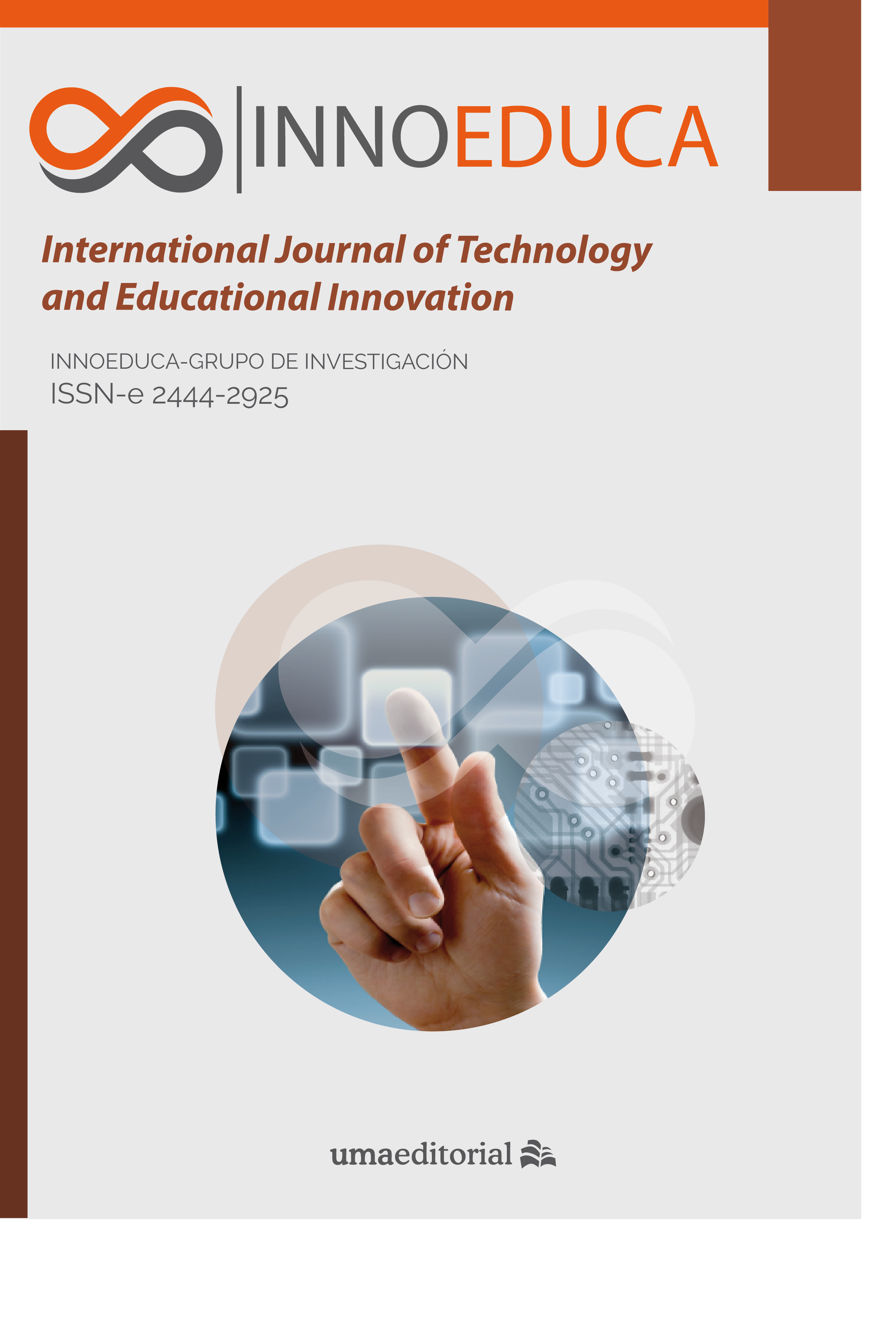Las perspectivas de estudiantes universitarios sobre el Big Data y su papel en el sistema educativo
DOI:
https://doi.org/10.24310/innoeduca.2020.v6i2.6809Palabras clave:
Big Data, estudiantes universitarios, validación psicométrica.Resumen
Hablar hoy de Big Data en educación es subrayar todas las potencialidades del manejo masivo de datos para la mejora de la calidad educativa, aunque de forma algo tardía. En este artículo se ofrecen los resultados más relevantes de un estudio realizado en un contexto universitario con estudiantes de la Universidad de Málaga. El objetivo del estudio ha sido conocer y comprender las percepciones, opiniones, conocimientos y actitudes relacionadas con el Big Data en el sistema educativo en una muestra de 104 estudiantes. La muestra del estudio fue no probabilística de carácter incidental. Para ello, se llevó a cabo un estudio de encuesta, utilizando la escala VABIDAE para recoger los datos. Se hizo un estudio psicométrico de la escala con los datos recogidos, así como un análisis estadístico descriptivo. Los resultados indican que los estudiantes tienen bastante desconocimiento sobre el Big Data y sus usos que se le puede dar en el campo educativo, aunque con una percepción positiva sobre su posible impacto. Ahora bien, se muestran críticos con los beneficios y perjuicios que puede llegar a tener en la calidad educativa.
Descargas
Métricas
Publicación Facts
Perfil de revisores N/D
Información adicional autores
Indexado: {$indexList}
-
Indexado en
- Sociedad Académica/Grupo
- N/D
- Editora:
- Universidad de Málaga
Citas
Borrego, M., Guardeño, C., Jiménez, C., Montero, R., Negro, C. y Matas, A. (2019). Cuestionario Sobre Big Data en Educación. Escala de Valoración Del Big Data Aplicado a la Educación (VABIDAE). Recuperado de: https://bit.ly/2mIdTIF.
Camargo-Vega, J. J., Camargo-Ortega, J. F. & Joyanes-Aguilar, L. (2015). Conociendo Big Data. Knowing the Big Data. Conhecendo Big Data. Revista Facultad de Ingeniería, 24(38), 63-77.
Daniel, B. K. (Ed.). (2017). Big data and learning analytics in higher education: current theory and practice. New York: Springer.
De la fuente, R. & Quijano, C. (2018). Privacidad en Big Data. Computerworld Red de conocimiento. Recuperado de: https://bit.ly/2p6A1xc.
Domínguez, D. (2018). Big data, analítica del aprendizaje y educación basada en datos. Universidad Nacional de Educación a Distancia (UNED), Madrid. 1-19. Recuperado de: https://bit.ly/2oedrSX.
Eynon, R. (2013). The rise of Big Data: what does it mean for education, technology, and media research? Learning, Media, and Technology, 38, 237–240.
Ferguson, R. (2014). Learning analytics don’t just measure students’ progress–They can shape it. Theguardian.com.
García, M., & Fuentes, A. (2016). Uso de Big Data en contextos educativos. In EDUNOVATIC 2016-I Congreso Virtual internacional de Educación, Innovación y TIC.: Del 14 al 16 de diciembre de 2016. Libro de actas (pp. 687-689). REDINE. Red de Investigación e Innovación Educativa.
Gartner (2014). Gartner says the Internet of Things will transform the Data Center. Retrieved August 5, 2014.
Gasevic, D., Dawson, S., & Jovanovic, J. (2016). Ethics and privacy as enablers of learning analytics. Journal of Learning Analytics, 3, 1–4.
Gómez, M. (2016, octubre 17). El Big Data como fuente de empleo [Entrada blog]. Recuperado de https://bit.ly/2mNzvDy.
González, A., & Maroto, A. (2017). Big data para la investigación lingüística y la educación bilingüe. International Journal for 21st Century Education, 1(4), 33-41.
Guthrie, D. (2013). The coming Big Data education revolution. US News, 15(08), 2013.
Hair Jr., J. F., Black, W. C., Babin, B. J. & Anderson, R. E. (2014). Multivariate data analysis (7th ed.). Edinburg: Pearson Education Limited.
Hazan, E., & Banfi, F. (2013). Leveraging big data to optimize digital marketing. McKinsey & Company. Retrieved January 13, 2015.
Ho, A. (2017). Advancing educational research and student privacy in the “Big Data” era. Washington, DC: National Academy of Education.
IDC (2012). Worldwide Big Data technology and services 2012 – 2016 forecast. Market Analysis.
Laney, D. (2001). 3D data management: Controlling data volume, velocity and variety. META group research note, 6(70), 1.
Li, K. C., Jiang, H., Yang, L. T., & Cuzzocrea, A. (Eds.). (2015). Big data: Algorithms, analytics, and applications. CRC Press.
Macfadyen, L. P. (2017). Overcoming barriers to educational analytics: how systems thinking and pragmatism can help. Educational Technology, 57, 31–39.
Manyika, J., Chui, M., Brown, B., Bughin, J., Dobbs, R., Roxburgh, C., & Hung Byers, A. (2011). Big Data: The Next Frontier for Innovation, Competition, and Productivity, McKinsey: McKinsey Global Institute.
Mohanty, H., Bhuyan, P., & Chenthati, D. (Eds.). (2015). Big data: A primer (Vol. 11). Springer.
Paniagua, P., & Cubo, S. (2018). Evaluación de las actitudes del profesorado hacia la aplicación de técnicas de “Big Data” en educación. In Campus digitales en la educación superior (pp. 221-234). Servicio de Publicaciones.
Pedraza, J., & Molina, J. M. (2017). El Big Data en el ámbito de los resultados docentes. In Educación, participación y escenarios digitales: Debates sobre la mediación digital en el siglo XXI (pp. 62-70). Editorial Comares.
Poulovassilis, A. (2016). Big Data and education. Technical Report BBKCS-16–01. Birkbeck.
Roberts, L. D., Howell, J. A., & Seaman, K. (2017). Give me a Customizable Dashboard: Personalized Learning Analytics Dashboards in Higher Education. Technology, Knowledge and Learning, 3(22), 317-333.
Yudatama, U., Nazief, B. A., Hidayanto, A. N., & Mishbah, M. (2017, October). Factors affecting awareness and attitude of IT governance implementation in the higher education institution: A literature review. In 2017 3rd International Conference on Science in Information Technology (ICSITech) (pp. 588-592). IEEE.
Publicado
Cómo citar
Número
Sección
Licencia
Todos los contenidos publicados por Innoeduca. International Journal of Technology and Educational Innovation están sujetos a la licencia de Creative Commons Reconocimiento-No comercial- SinObraDerivada 4.0 Internacional, cuyo texto completo se puede consultar en https://creativecommons.org/licenses/by-nc-nd/4.0/legalcode. Por lo tanto, la copia, distribución, comunicación pública, obras derivadas y el uso comercial de los contenidos están permitidas siempre que la fuente y el autor del texto se citen.
Es responsabilidad de los autores obtener los permisos necesarios de las imágenes que están sujetas a derechos de autor.

Este obra está bajo una licencia de Creative Commons Reconocimiento-NoComercial-SinObraDerivada 4.0 Internacional.













241.png)







